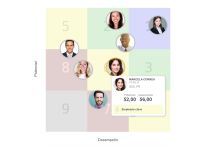Nine Box
The 9-Box Matrix, also known as the Talent Map, is an essential strategic tool in talent management within organizations. This matrix allows the identification of key employees, those with high performance and significant development potential. By classifying collaborators into 9 visual quadrants, the 9-Box Matrix facilitates the identification of development needs, commitment levels, and the potential to become future leaders within the company.
Benefits of the 9-Box Matrix in Talent Management
Using the 9-Box Matrix in talent management offers several strategic advantages for organizations:
-
Visual positioning of employees: The 9-Box Matrix allows each employee to be placed based on their performance and potential, optimizing decisions related to their professional development and growth within the organization.
-
Talent development: Thanks to the 9-Box Matrix, companies can identify areas for improvement for each collaborator and offer personalized training programs to enhance their performance and increase their commitment to the company.
-
Identification of potential leaders: The 9-Box Matrix helps identify collaborators with high leadership potential, allowing the design of effective succession plans and ensuring the continuity of talent in key positions.
-
Detection of low performance: Additionally, the 9-Box Matrix helps identify employees with low performance, enabling the detection of potential development areas or even planning a strategic relocation within the company.
How the 9-Box Matrix Works
The 9-Box Matrix classifies employees based on two key evaluations: their performance and their potential. These two metrics are plotted on a plane divided into 9 quadrants:
- Y-Axis: Measures the potential of the employee.
- X-Axis: Measures the performance of the employee.
Each employee is placed in the corresponding quadrant according to their scores in these two areas, providing a clear view of their position within the organization.
The Quadrants of the 9-Box Matrix
The 9-Box Matrix is divided into 9 quadrants, categorized as follows:
- Superstar: Employees with high performance and high potential.
- High Potential: Employees with great potential, but performance still to be developed.
- Star in their area: Employees who are very good in their area but have less potential for larger roles.
- Excellent Performance: Employees who stand out for their performance but have limited growth potential.
- Enigma: Employees with variable performance and uncertain potential.
- Key Employee: Collaborators with good performance and promising potential.
- Good Performance: Employees with good performance but little development potential.
- Dilemma: Employees with low performance but high potential.
- Consider Position: Employees with low performance and unclear potential for improvement.
This visual classification allows organizations to make strategic decisions about promotions, training programs, and development plans efficiently.
The Importance of the 9-Box Matrix in Talent Management
The 9-Box Matrix is a powerful tool for identifying, developing, and retaining key talent within an organization. By classifying employees based on their performance and potential, companies can make more informed and strategic decisions about talent management. Using a visual map like the 9-Box Matrix ensures that the right people are in the right roles, promoting a culture of continuous development and leadership.
Building a Nine Box Talent Matrix has never been easier. With Hrider's N-Box functionality, you can create 9-box matrices as well as 4-, 16-, and 25-quadrant matrices that correlate different variables such as performance and potential. In this tutorial you will learn what they are and how to easily create them step by step.
